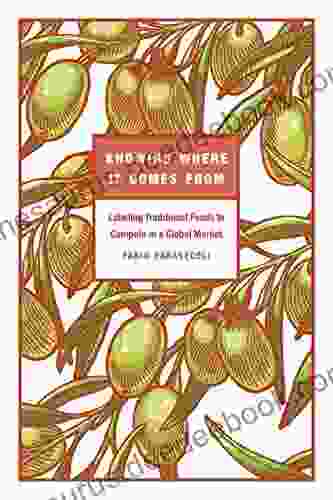Labeling Traditional Foods To Compete In Global Market

5 out of 5
| Language | : | English |
| File size | : | 3687 KB |
| Text-to-Speech | : | Enabled |
| Screen Reader | : | Supported |
| Enhanced typesetting | : | Enabled |
| Word Wise | : | Enabled |
| Print length | : | 272 pages |
| Hardcover | : | 200 pages |
| Item Weight | : | 10.2 ounces |
| Dimensions | : | 6 x 0.48 x 9 inches |
| Paperback | : | 210 pages |
In an era of globalization, traditional foods face unique challenges in capturing the attention of international consumers. Effective labeling plays a pivotal role in conveying the essence of these culinary treasures, showcasing their cultural heritage, and ensuring compliance with regulatory standards.
This comprehensive guide explores the crucial aspects of labeling traditional foods for global success, empowering producers and exporters to unlock new markets and elevate their products beyond borders.
Captivating Consumers: The Art of Enticing Labels
The label of a traditional food is its first point of contact with the consumer. It serves as a visual ambassador, promising a taste of cultural heritage and an unforgettable culinary experience.
- Visual Appeal: Create labels that are visually stunning, utilizing vibrant colors, high-quality images, and eye-catching fonts. Ensure that the design complements the food's cultural heritage, evoking a sense of authenticity and tradition.
- Clear and Concise: Provide essential information in an easily readable format. Highlight the food's name, origin, and key ingredients, using language that resonates with the target audience. Avoid jargon or technical terms that may alienate consumers.
- Storytelling: Engage consumers with a compelling narrative that tells the story behind the food. Share its cultural significance, the region it originates from, and the artisanal methods used in its preparation. This emotional connection fosters a deeper appreciation for the product.
Preserving Heritage: Conveying Cultural Identity
Traditional foods are deeply rooted in cultural traditions, embodying the history, values, and beliefs of a region. Effective labeling must convey this cultural heritage, establishing a connection between the product and its origins.
- Cultural Symbols and Motifs: Integrate cultural symbols, motifs, and colors into the label design. These visual cues instantly communicate the food's cultural identity, appealing to consumers who seek authentic and traditional experiences.
- Historical Context: Provide historical background or anecdotes that highlight the food's significance within the local culture. This storytelling enhances the product's value, showcasing its deep connection to the region's culinary heritage.
- Traditional Preparation Methods: Emphasize the artisanal nature of the food by showcasing traditional preparation methods. Highlight the use of local ingredients, handcrafted techniques, and the preservation of cultural practices.
Navigating Regulatory Compliance: Ensuring Safety and Transparency
Navigating regulatory compliance is essential for ensuring the safety and transparency of traditional foods in global markets. Labels must adhere to specific requirements, providing consumers with vital information.
- Ingredients List: Provide a comprehensive list of ingredients, including allergens and any additives or preservatives. This transparency builds trust with consumers and ensures compliance with food safety regulations.
- Nutritional Information: Include nutritional information, such as calories, fat, protein, and carbohydrates. This empowers consumers to make informed choices and cater to specific dietary needs.
- Storage Instructions: Clearly indicate proper storage and handling instructions to ensure the food's freshness and safety. This information protects consumer health and minimizes the risk of spoilage or contamination.
- Country of Origin: State the country where the food was produced. This transparency allows consumers to make informed choices about the source of their food and supports local economies.
Case Studies: Success Stories in Global Markets
Numerous traditional foods have achieved remarkable success in global markets by effectively leveraging labeling strategies.
- Tandoori Chicken: This classic Indian dish gained worldwide popularity thanks to its distinctive red color, aromatic spices, and traditional presentation. The label design captured the essence of Indian culinary culture, featuring vibrant colors and traditional motifs.
- Sushi: Japanese sushi has captivated global consumers with its delicate flavors and artistic presentation. The labels often showcase the intricate craftsmanship of sushi chefs, highlighting the use of fresh ingredients and traditional techniques.
- Kimchi: Korean kimchi has become a global sensation, renowned for its spicy and fermented flavors. The labels emphasize the traditional fermentation process, using natural ingredients and showcasing its cultural significance as a staple in Korean cuisine.
Effective labeling is the key to unlocking the global success of traditional foods. By capturing consumer attention, conveying cultural heritage, and ensuring regulatory compliance, producers and exporters can empower their products to compete in international markets.
Embark on this journey of culinary exploration, showcasing the unique flavors and traditions of your traditional foods to the world. With thoughtful labeling strategies, you can transform these culinary treasures into global icons, fostering cultural exchange and enriching the world's culinary landscape.
5 out of 5
| Language | : | English |
| File size | : | 3687 KB |
| Text-to-Speech | : | Enabled |
| Screen Reader | : | Supported |
| Enhanced typesetting | : | Enabled |
| Word Wise | : | Enabled |
| Print length | : | 272 pages |
| Hardcover | : | 200 pages |
| Item Weight | : | 10.2 ounces |
| Dimensions | : | 6 x 0.48 x 9 inches |
| Paperback | : | 210 pages |
Do you want to contribute by writing guest posts on this blog?
Please contact us and send us a resume of previous articles that you have written.
 Book
Book Chapter
Chapter Text
Text Story
Story Genre
Genre Reader
Reader Paperback
Paperback Paragraph
Paragraph Shelf
Shelf Glossary
Glossary Bibliography
Bibliography Foreword
Foreword Preface
Preface Annotation
Annotation Footnote
Footnote Codex
Codex Tome
Tome Bestseller
Bestseller Classics
Classics Narrative
Narrative Autobiography
Autobiography Memoir
Memoir Reference
Reference Encyclopedia
Encyclopedia Dictionary
Dictionary Resolution
Resolution Librarian
Librarian Stacks
Stacks Archives
Archives Study
Study Scholarly
Scholarly Lending
Lending Academic
Academic Rare Books
Rare Books Literacy
Literacy Study Group
Study Group Thesis
Thesis Storytelling
Storytelling Awards
Awards Theory
Theory Ella Cooper
Ella Cooper Denis Mack Smith
Denis Mack Smith Mark Groome
Mark Groome Phil Jourdan
Phil Jourdan Emma Chichester Clark
Emma Chichester Clark Ton Viet Ta
Ton Viet Ta Joseph Plumb Martin
Joseph Plumb Martin Lisa L Moore
Lisa L Moore Pierluigi Panza
Pierluigi Panza Lawrence Weschler
Lawrence Weschler Sean J Savage
Sean J Savage Stephanie Kay
Stephanie Kay John Whitelegg
John Whitelegg Stuart Elden
Stuart Elden Peter Michael
Peter Michael Susan Supernaw
Susan Supernaw Dan Bouk
Dan Bouk Richard Wagner
Richard Wagner Sharon Barnes
Sharon Barnes Emily D Edwards
Emily D Edwards
Light bulbAdvertise smarter! Our strategic ad space ensures maximum exposure. Reserve your spot today!
 Marvin HayesFollow ·6.9k
Marvin HayesFollow ·6.9k Boris PasternakFollow ·9.6k
Boris PasternakFollow ·9.6k George HayesFollow ·9.5k
George HayesFollow ·9.5k Jim CoxFollow ·6.7k
Jim CoxFollow ·6.7k Dalton FosterFollow ·18.1k
Dalton FosterFollow ·18.1k Chandler WardFollow ·16.7k
Chandler WardFollow ·16.7k Ashton ReedFollow ·7.6k
Ashton ReedFollow ·7.6k Henry Wadsworth LongfellowFollow ·10.3k
Henry Wadsworth LongfellowFollow ·10.3k

 Gary Reed
Gary ReedWeb to Web for Beginners: A Comprehensive Guide to...
In today's interconnected world, websites...

 Elliott Carter
Elliott CarterThe Moon Is Down: John Steinbeck's Poignant Portrait of...
In the annals of literature, John...

 Dalton Foster
Dalton FosterMark The Mechanic: The Incredible Story Of A Young...
In the vibrant realm of robotics, where...

 Fred Foster
Fred FosteriPhone 13 Pro Max User Guide: Everything You Need to Know
The iPhone 13 Pro Max...

 Rodney Parker
Rodney ParkerPope John Paul II: The Pocket Giant Who Inspired Millions
Pope John Paul II, or...
5 out of 5
| Language | : | English |
| File size | : | 3687 KB |
| Text-to-Speech | : | Enabled |
| Screen Reader | : | Supported |
| Enhanced typesetting | : | Enabled |
| Word Wise | : | Enabled |
| Print length | : | 272 pages |
| Hardcover | : | 200 pages |
| Item Weight | : | 10.2 ounces |
| Dimensions | : | 6 x 0.48 x 9 inches |
| Paperback | : | 210 pages |













